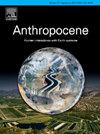Deposition and 14C-based source apportionment of black carbon in a small lake in southern Sweden since 1450 CE
IF 3.9
2区 地球科学
Q2 ENVIRONMENTAL SCIENCES
引用次数: 0
Abstract
Black carbon (BC) is produced by incomplete combustion of biomass and fossil fuels and is released as aerosols to the atmosphere with effects on the climate, environment, and human health. Current BC emissions are well monitored in many parts of the world. However, the geographical coverage is limited, and historical records of BC accumulation are still scarce. Here we present a quantification of soot BC (SBC) concentrations in sediments deposited in a small lake in southern Sweden during recent centuries. The SBC was quantified using chemical and thermal oxidation at 375°C (CTO375). The SBC concentrations are low (c. 3 mg/g) in the preindustrial sediments older than 1650 CE and reached maximum concentrations (c. 8.5 mg/g) after 1900 CE. The increase in SBC accumulation started before the major phase of industrialisation of Sweden in the 19th century, probably related to local emission sources from increased biomass burning or coal extraction in the region that expanded from the second half of the 17th century. The effect of industrialisation is seen as an increase in SBC concentration and accumulation from around 1875 CE. The maximum accumulation of SBC was observed between 1950 CE and 2005 CE. The fraction of the SBC derived from fossil fuels was estimated using radiocarbon-based source apportionment. Biomass was the main source of SBC throughout the studied period. The maximum contribution from fossil fuel was observed between 1970 CE and 1990 CE, amounting to 26 −28 % of the total SBC. From 2000 CE the SBC deposition was dominated by biomass sources, probably because of a transition from fossil fuels to biomass as the dominant source of heating in Sweden.
1450年以来瑞典南部一个小湖泊中黑碳的沉积和基于14c的来源分配
黑碳(BC)是由生物质和化石燃料的不完全燃烧产生的,并以气溶胶的形式释放到大气中,对气候、环境和人类健康产生影响。目前,世界上许多地方都对碳排放进行了很好的监测。然而,地理覆盖范围有限,BC积累的历史记录仍然很少。在这里,我们提出了近几个世纪以来在瑞典南部一个小湖泊沉积的沉积物中烟灰BC (SBC)浓度的量化。在375°C (CTO375)下使用化学氧化和热氧化对SBC进行定量。在1650 CE以前的工业前沉积物中,SBC浓度较低(c. 3 mg/g),在1900 CE以后达到最大浓度(c. 8.5 mg/g)。SBC积累的增加开始于19世纪瑞典工业化的主要阶段之前,可能与该地区从17世纪下半叶开始扩大的生物质燃烧或煤炭开采增加的当地排放源有关。工业化的影响被视为从1875年左右开始SBC浓度和积累的增加。在1950年至2005年期间观测到最大的SBC积累。使用放射性碳源分摊法估算了来自化石燃料的SBC的比例。在整个研究期间,生物质是SBC的主要来源。化石燃料的最大贡献在1970年至1990年期间观测到,占总SBC的26% −28% %。从公元2000年开始,SBC沉积以生物质来源为主,这可能是因为瑞典从化石燃料向生物质作为主要供暖来源的转变。
本文章由计算机程序翻译,如有差异,请以英文原文为准。
求助全文
约1分钟内获得全文
求助全文
来源期刊

Anthropocene
Earth and Planetary Sciences-Earth and Planetary Sciences (miscellaneous)
CiteScore
6.30
自引率
0.00%
发文量
27
审稿时长
102 days
期刊介绍:
Anthropocene is an interdisciplinary journal that publishes peer-reviewed works addressing the nature, scale, and extent of interactions that people have with Earth processes and systems. The scope of the journal includes the significance of human activities in altering Earth’s landscapes, oceans, the atmosphere, cryosphere, and ecosystems over a range of time and space scales - from global phenomena over geologic eras to single isolated events - including the linkages, couplings, and feedbacks among physical, chemical, and biological components of Earth systems. The journal also addresses how such alterations can have profound effects on, and implications for, human society. As the scale and pace of human interactions with Earth systems have intensified in recent decades, understanding human-induced alterations in the past and present is critical to our ability to anticipate, mitigate, and adapt to changes in the future. The journal aims to provide a venue to focus research findings, discussions, and debates toward advancing predictive understanding of human interactions with Earth systems - one of the grand challenges of our time.
 求助内容:
求助内容: 应助结果提醒方式:
应助结果提醒方式:


